The Victoria Cross at Auction Part 2: 1983-1999

The Victoria Cross at Auction Part 2: 1983-1999
On the 8th December 1983, almost a century after having bought our first V.C. at auction, Spink decided to hold their first medals auction, having previously been exclusively dealers. The final lot of the sale (Lot 404) was the Zulu War V.C. pair to Private Thomas Flawn, 94th Foot. Much interest had been generated by Spink's entry into the auction market, and the lot sold for a creditable £19,000, fractionally below the top estimate of £20,000, but still a record price for a Victorian V.C. at auction, and, perhaps rather more satisfyingly, significantly more than next-door neighbour's Christie's had ever achieved. (The Flawn V.C., whilst being the first V.C. sold by Spink at auction, was almost the last V.C. sold by any auction house without attracting a buyer's premium.)
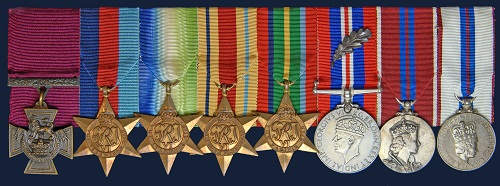 |
James Margennis
On the 6 May 1986 the V.C. group to Field Marshal Sir George White appeared for auction at Sotheby's. As one of only Four Field Marshals to have received the V.C. (the others being Lord Roberts, Sir Evelyn Wood, and Viscount Gort), the lot thus became the highest ranking Army V.C. group ever to appear at auction. His full entitlement, besides the V.C., won during the Second Afghan War for the battles of Charasia and Kandahar, included the First Class insignia of the Orders of the Bath (G.C.B.), St Michael and St. George (G.C.M.G.), the Indian Empire (G.C.I.E.), and the Royal Victorian Order (G.C.V.O.), as well as the Order of Merit (O.M.). Indeed it was only due to the statutes in force at the time, which required the insignia of the Order of the Star of India to be returned on the death of the recipient, that prevented the G.C.S.I. from being represented. Accompanying the medals in the lot was his Field Marshal's Baton, presented in 1903. Featuring on both the front and back covers of the catalogue, and running to a full nine pages within, where the lot was described as 'The highly important group of Orders, Decorations, and Medals awarded to Field Marshal Sir George White, Commanding Officer at the Defence of Ladysmith', the lot was bought by the Gordon Highlanders Museum, White's old Regiment, for a hammer price of £55,000 (£60,500 including premium). Obviously this figure owes as much to his later career, which culminated in his service during the Boer War, and the other honours and awards that came his way, as it does to the V.C. action, and it is interesting to speculate to what extent the V.C. on its own contributed to the overall price.
Although it would prove a hard act to follow, Sotheby's next sale, on the 3 July 1986, included what was probably the most significant medal lot ever to be sold at auction, when one considers the effect that this sale would later have on the V.C. market. The final lot of the sale, which again featured on both the front and back covers, was the famous midget Submarine V.C. group awarded to Leading Seaman James Magennis, Royal Navy, for his gallantry during an attack on a Japanese Cruiser off Singapore. Magennis was part of the four man crew of HM Submarine XE-3, a craft so small that even her 5ft 4in commander could not stand upright in her. Commanded by Lieutenant Commander Ian Fraser, in July 1945 the XE-3 was ordered to sink the Takao, a Japanese heavy cruiser moored in the Johore Strait, Singapore. During the long approach up the Singapore Straits the XE-3 deliberately left the believed safe channel and entered mined waters to avoid detection. Finally, after a hair-raising run past hydrophone posts, over loops, and through controlled minefields, the XE-3 penetrated an anti-submarine boom and entered the shallow anchorage on the 31 July. Forced to scrape along the seabed with only ten feet of water above her, she finally reached the Takao. The target was aground both fore and aft, and only under the midship portion was there sufficient water for the submarine to place herself under the cruiser. After forty minutes of trying, Fraser eventually managed to force the submarine directly under the target. The next task was to place the limpet mines. Owing to the fact that the XE-3 was tightly jammed under the Takao, the diver's hatch could not be fully opened, and Magennis had to squeeze himself through the narrow space available. Struggling out, damaging an air-seal in his breathing apparatus in the process, he experienced great difficulty in placing his limpets on the bottom of the cruiser due to the thick layer of barnacles upon which the limpets would not hold. Before a mine could therefore be placed Magennis had thoroughly to scrape the area clear, and in order to secure the limpets he had to tie them in pairs by a line passing under the cruiser keel. This was very tiring work for a diver, and he was moreover handicapped by a steady leakage of oxygen which was ascending in bubbles to the surface. A lesser man would have been content to place a few limpets and then to return to the craft. However, Magennis persisted until he had placed his full outfit before returning to the craft in an exhausted condition.
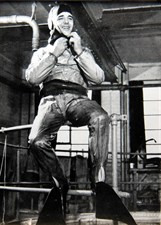 |
Ian Fraser
The next task was to release the twoside charges. The port charge dropped away clearly, but the starboard charge was stuck. But a new, more serious, problem had arisen. Owing to the falling tide the 10,000 ton cruiser was now resting solidly on top of the midget submarine, and there was the very real chance that they would be blown up by their own charges. For fifty minutes they tried to break free, but just as they were prepared to admit defeat and accept the consequences, the XE-3 shot out astern and cleared the Takao. This however was not the end of their problems since two and a half tons of explosives in the starboard charge were still stuck to the submarine's side. Fraser volunteered to go outside and release the charge, but Magennis insisted that, as the more experience diver, he was the man to carry out the job, telling Fraser 'I'll be all right as soon as I've got my wind, sir.' After seven minutes of nerve-racking work he succeeded in releasing the carrier. At 9:30pm that evening the charges detonated, tearing a 60 foot by 30 foot hole in the bottom of the Takao. Both Fraser and Magennis were awarded the V.C.; the other two crew members were awarded a D.S.O. and a C.G.M.
This was the first Second World War Naval V.C. to be offered for sale at auction, and fierce bidding on the day of the sale took the price up from a pre-sale estimate of £24,000-26,000 to a final hammer price of £29,000 (£31,900 including premium), the third highest price of all time, and a record for a Naval V.C. The successful buyer was Michael Ashcroft (later Lord Ashcroft), fulfilling for him 'a boyhood ambition to own an example of Britain's premier bravery award.' At the time, he considered the Magennis V.C. to be a one-off purchase, but as he would later admit 'once I had one example, a life-long interest in bravery swiftly turned into a passion to collect more V.C.s.' Thus were the seeds sown for what would eventually become the largest collection of V.C.s ever assembled.
Two years later, at Sotheby's on the 10 November 1986, Ian Fraser decided to put his own V.C. group up for auction, selling for fractionally more than Magennis' Cross at £30,000 (£33,000 including premium). Appropriately enough, the buyer was Michael Ashcroft, who was thus able to re-unite the two V.C.s given for this heroic action.
The next V.C. after the Magennis V.C. to appear on the market was at Spink, when on the 26 September 1986 they offered for sale the outstanding V.C. Group for Rorke's Drift awarded to Acting Assistant Commissary James Langley Dalton, one of 11 V.C.s awarded for the Defence of Rorke's Drift in the Zulu War, 22-23 January 1879. This was only the second Rorke's Drift V.C. to appear thus catalogued at auction, and the first for over 80 years since Corporal William Allen's V.C. had sold for £72 back in 1906. Then the price was merely good; this time it was spectacular, with the Dalton V.C. selling for a staggering £62,000 (£66,960 including premium).
No fewer than 16 Victoria Crosses were offered for sale at auction in 1988, the first of these being the V.C. to Edward Daniel, now appearing at auction for the fifth time since it had sold for £40 back in 1930. This time it sold at Sotheby's on the 21 March 1988 for £18,000 (£19,800 include premium). However, all of the other Crosses offered for sale that year were eclipsed, both in price and certainly in terms of publicity, by the V.C. awarded to William Leefe Robinson. The bland citation that appeared in the London Gazette on the 5September 1916, just two days after the action took place, scarcely does justice to the award: 'For the most conspicuous bravery. He attacked an enemy airship under circumstances of great difficulty and danger, and sent it crashing to the ground as a flaming wreck. He had been in the air for more than two hours and had previously attacked another airship during his flight.'
The actual circumstances are rather more telling. On the night of 2/3 September 1916 over Cuffley, Hertfordshire, Robinson, flying a converted B.E.2c night fighter, sighted a German airship, one of 16 which had left bases in Germany on a mass raid over England. The airship was actually the wooden-framed Schutte-Lanz SL 11, not the Zeppelin which many onlookers assumed. Robinson made an attack at an altitude of 11,500 feet approaching from below and closing to within 500 feet, raked the airship with machine-gun bullets. As he was preparing for another attack, it burst into flames and crashed in a field, killing the entire crew.
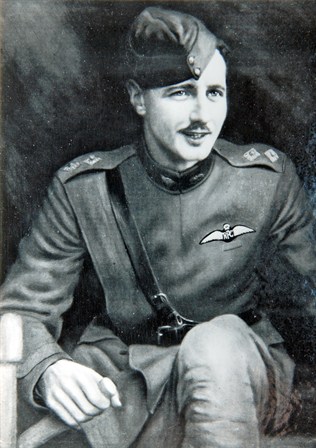 |
William Leefe Robinson
This action was witnessed by thousands of Londoners who, as they saw the airship descend in flames, cheered and sang the national anthem. The propaganda value of this success was of enormous value to the country, as it indicated that the German airship threat could be countered. When Robinson was awarded the V.C. by the King at Windsor Castle, huge crowds of admirers and onlookers were in attendance. This was, after all, the first V.C. to be awarded for an action in the U.K. (one of only three to date, and the second to appear at auction). Seventy years later the interest was just as high, and a special auction catalogue was produced for the lot, the first time that a V.C. had been afforded its own single-lot catalogue. The group was taken on a mini tour of the country, including appropriately enough the 'William Leefe Robinson' public house near to where the recipient is buried. Offered for sale at Christie's on the 22 November, it far exceeded the pre-sale estimate, and for a while looked like it might finally break the all time record. In the end it fell just short, selling to Michael Ashcroft for a hammer price of £92,000 (£99,000 including premium). Incidentally, this made the two V.C.s to have been awarded for an action in this country that had appeared at auction the two highest selling V.C.s of all time (the third V.C. awarded for an action in the U.K., to Leading Seaman Jack Mantle, Royal Navy, for gallantry during an air raid on Portland, has not appeared at auction).
The final V.C. group to be sold at auction in 1988 was the St. George's Day 1918 Zeebrugge Raid V.C. awarded posthumously to Lieutenant-Commander George Bradford, Royal Navy, one of eight V.C.s to be awarded, the most for any Naval action, and one of the finest examples of cold courage in the annuals of Naval and Military history. Much has been written about the Zeebrugge raid and the gallantry shown by those who took part - indeed it was recognized before hand that the mission was going to be extremely hazardous, and that many would not return, to the extent that the Admiralty insisted that those taking part should all be single men, and volunteers. Bradford commanded the naval storming parties embarked in H.M.S. Iris II. Great difficulty was experience in placing the parapet anchors when the ship came alongside the harbour mole, and it seemed that the storming party would become a sitting target, unable to leave the ship. Although securing the ship was not part of his duties, Bradford climbed a derrick that was projecting out over the mole and, under heavy fire, with the derrick crashing against the mole because of the violent tossing of the ship, he picked his moment and jumped with the anchor. He had just placed it securely in position when his bullet-ridden body was swept into the sea. Initially he was only gazetted with a posthumous Mention in Despatches, an outcome which prompted Admiral Keyes, who planned the raid, to write to the Admiralty: 'Lieutenant Commander Bradford's action was one of absolute self-sacrifice, without a moment's hesitation he went to a certain death, recognizing that in such action lay the only possible chance of success.' Writing also to Bradford's mother, he wrote: 'You may hear before my letter reaches you that your very gallant son George has been awarded the posthumous Victoria Cross which he so heroically earned on his birthday. I knewhe would eventually get it, because although many actions were performed on that night by officers and men who survived, and by others who gave their lives, amongst the latter your son's act of glorious self-sacrifice stood out, I thought, alone…' Bradford himself was part of one of the most extraordinary families of the Great War, one of four brothers who between them won two V.C.s, one D.S.O., and two M.C.s. Opening at £12,000, at Spink on the 8 December, the bidding soon reached £16,500, before two final very late bids lifted it to £17,500 (£19,250 including premium). Whilst this was still an above average price at the time, it was less than a fifth of the price paid earlier in the year for the William Leefe Robinson V.C. group (both groups comprising the V.C., 1914-15 Star, British War Medal, and Victory Medal), and is perhaps a good indicator as to the state of the market at the time- the (very) top end V.C.s were beginning to make serious money, whereas the 'merely good' had a lot of catching up to do.
On the 15 September 1990, the record price for a V.C., which many in the business had assumed would last for years, if not decades, to come, was finally broken. Not surprisingly, it was another flying V.C. which would take the record from the Nicolson group.
By 1915 over 600 Victoria Cross had been awarded, of which 52 were to he Royal Navy and Royal Marines, 417 to the British Army; 93 to HEIC and Indian Armies; 37 to Overseas and Dominion Forces; and 4 to Civilians. The 604th Victoria Cross to be awarded, and the first to an airman, was that to Lieutenant William Rhodes-Moorhouse, Royal Flying Corps. Born in 1897, and educated at Harrow and Trinity College, Cambridge, Rhodes-Moorhouse epitomized the pioneering spirit that was to be found in many of the early aviators. Learning to fly at his own expense, he took part in many of the early flying meetings in England and America, and in July 1912 he became the first person to fly across the English Channel carrying passengers. Enlisting in the Royal Flying Corps at the outbreak of War in August 1914, he embarked for France in March 1915, joining No.2 Squadron at Merville. On the 26 April 1915, following a German advance, Orders were received by No.2 Squadron to bomb the enemy's rail network to prevent her from bringing supplies up to the front. Setting off that afternoon, with a single 100 lb bomb suspended below his aircraft, Rhodes-Moorhouse set course for Courtrai rail junction. Sweeping low over the location, he released his bomb on target at a height of 300 ft, but immediately entered a hail of small arms fire, which tore into his plane and caused severe wounds. Abandoning the option of landing to receive medical treatment as a prisoner of war, he chose instead to try to return to Allied lines. Descending to 100 ft to increase speed, he ran the gauntlet of ground fire again, and was wounded twice more. Losing blood steadily, and fighting increased weakness and dizziness, he eventually, after 35 minutes, made it back to his unit's airfield. Lifted gently from his shattered cockpit, the plane riddled with 95 bullet and shrapnel holes, and the floor crimson with blood, he insisted upon making his report before allowing himself to be moved to the hospital. Throughout the night the medical personnel did all that was possible, but by noon the following day his life was slowly ebbing away, and he died that afternoon. For his great gallantry he was awarded the Victoria Cross- having contributed so much to the mastery of the skies in peacetime, it was perhaps fitting that he should have the added distinction of become the first airman to be awarded his country's highest honour in time of war. His medal group, together with his flying Log Book, was the star medal lot at Sotheby's Aircraft and Aeronautica sale held at Hendon on the 50th Anniversary of the Battle of Britain, and sold for a new world record price of £115,000 (£126,500 including premium).
In total, just 51 airmen have been awarded the Victoria Cross, out of the 1,353 V.C.s and 3 Bars awarded to date. Clearly, the scarcity of the awards, particularly when compared with the Army, has a significant bearing on the price, and it was perhaps no surprise that, by 1991, the top three highest-selling V.C.s at auction had all been awarded to men of the Royal Flying Corps of Royal Air Force.
Continuing this trend was the Second War posthumous V.C. awarded to Flying Officer Leslie Manser, Royal Air Force Volunteer Reserve, which sold at Christie's on the 24 April 1992. Returning from a raid on Cologne, his plane was the target of heavy anti-aircraft fire and was repeatedly hit. The citation for his V.C. is an epic of absolute determination and devotion to his crew: 'Pilot and crew could all have escaped safely by parachute. Nevertheless Flying Officer Manser disregarding the obvious hazards persisted in his attempts to save aircraft and crew from falling into enemy hands. Despite all his efforts, the Manchester began to lose height. At this critical moment, he once more distained the alternative of parachuting to safety with his crew. Instead, with grim determination, he set a new course for the nearest base, accepting for himself the prospect of almost certain death in a firm resolve to carry on to the end. Soon, the aircraft became extremely difficult to handle and, when a crash was inevitable, Flying Officer Manser ordered the crew to bale out. A sergeant handed him a parachute but he waved it away, telling the non-commissioned officer to jump at once as he could only hold the aircraft steady for a few seconds more. While the crew were descending to safety they saw the aircraft, still carrying their gallant captain, plunge to earth and burst into flames. In pressing home his attack in the face of strong opposition, in striving, against heavy odds, to bring back his aircraft and crew and, finally when extreme peril, thinking only of the safety of his comrades, Flying Officer Manser displayed determination and valour of the highest order.' He was just 19 years of age.
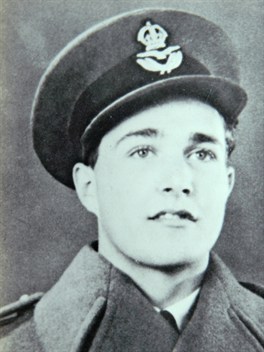 |
Leslie Manser
Manser's family never claimed his Second War campaign medals, and so it was just the single V.C. that was offered for sale. Estimated at £50,000-60,000, it sold for a hammer price of £52,000 (£57,200 including premium), a world record price for just a single V.C. at auction.
In 1992 Sotheby's started a new programme of themed sales, based around the three Services. First up, on the 20 May, was the Royal Navy, and the star lot in the sale was the Crimean V.C., C.G.M. group to Quartermaster William Rickard, Royal Navy, for carrying out what today would be termed a 'Commando' raid. Unfortunately the sale, given the fact that Naval collectors are greatly outnumbered by their Army counterparts, was not very well attended, and the V.C. group sold over the telephone at the low estimate of £18,000 (£19,800 including premium). Next up was the Army, on the 17 September, and again there was a V.C. group for sale, the Great War V.C., M.C. group to Captain Alfred Toye, Middlesex Regiment. With the auction better attended, the group was bid up to £23,000 (£25,300 including premium). But it was the R.A.F. sale, on the 19 September 1992, that caused greatest interest, offering as it did 'the highlight of this year's entire auction calendar', the highly important V.C., D.S.O. and Two Bars, M.C. and Bar group to Major Edward Mannock, Royal Air Force, the highest scoring and most decorated pilot of the Great War. In closing his V.C. citation, it was written: 'This highly distinguished officer, during the whole of his career in the Royal Air Force, was an outstanding example of fearless courage, remarkable skill, devotion to duty, and self sacrifice, which has never been surpassed.' Although there was no published pre-sale estimate in the catalogue, it was widely anticipated that the then auction record of £115,000, set by the Rhodes-Moorhouse V.C., would be surpassed. The group attracted a good deal of pre-sale publicity in both the national and specialist press, and on the day of the sale as hoped for and predicted sold for a new world record price of £120,000 (£132,000 including premium).
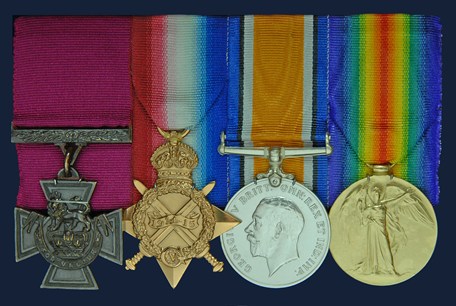
William Rhodes-Moorhouse
In August 1993 Sotheby's Australia offered for sale the Vietnam V.C. awarded posthumously to Warrant Officer Kevin Wheatley, Australian Army Training Team, making this the most-recently awarded V.C. to be offered for sale at auction to date. On the 13 November 1965, in Vietnam, Wheatley was killed having insisted on staying with a wounded comrade to protect him from the Viet Cong, against overwhelming odds, despite having ample opportunity to make good his escape. This was in many ways a watershed for the V.C., in that it was the first and last war (as opposed to some minor skirmish) in which the V.C. was awarded for an act of gallantry performed during hostilities to which the British Government was not a party. It was also the last occasion on which the V.C. was awarded to servicemen serving the former Dominions, even if they are fighting alongside British forces, as Canada, Australia, and New Zealand now award their own versions of the V.C. under a separate Warrant.
Wheatley's Cross sold for $A150,000 (A$165,000 including premium; approximately £68,400 or £75,200 including premium).
On the 28 March 1995 Spink offered for sale the famous 'Commando' V.C. group posthumously awarded to Lieutenant Colonel Geoffrey Keyes, Royal Scots Greys, for the celebrated 'Rommel Raid', one of the most daring episodes of the Second World War. In the autumn of 1941, the British 8Army stood on the frontiers of Egypt. Tobruk, encircled by the German Africa Corps, was still holding out. General Cunningham was preparing an offensive for the 18 November with the intention of relieving Tobruk and sweeping the enemy from the area. General Rommel was also planning an offensive to eliminate the British from Tobruk, timed for the 23November. Lieutenant-Colonel Keyes meanwhile had formulated his own plan- to attack and destroy with a small commando force the German Headquarters 250 miles behind enemy lines, and to capture General Rommel. The attack was timed to coincide with the British raid, at midnight on the 17-18 November. Despite knowing only too well that the odds were stacked heavily against him, Keyes insisted on leading the raid, taking with him just one other officer and an NCO. They succeeded on entering the Headquarters, and killed the occupants of the first room they entered, but the sound of gunfire had roused the rest of the sleeping occupants, and as Keyes himself flung open the door of the next room he was shot almost immediately, and fell back, mortally wounded. As fate would have it, General Rommel was not in the house at the time, but when he heard of the attack on his Headquarters, and the gallantry shown by Lieutenant-Colonel Keyes, he had the courtesy to send his personal chaplain to conduct Keyes' funeral, who was buried outside the village with full military honours.
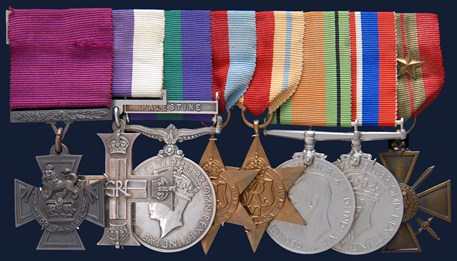
Geoffrey Keyes
The group sold for a hammer price of £110,000 (£121,000 including premium), making it the record price paid for an Army V.C., the record price for a Second World War V.C., and the third highest price achieved for any V.C. group at auction.
In July 1997 Spink started a remarkable run that would see them sell 22 V.C.s at auction over the next two and half years, and claim the world record price for the first time. Amongst the first of these was the posthumous V.C. group to Flight Lieutenant David Lord, Royal Air Force, Transport Command's only V.C. of the Second World War. On the 19 September 1944, at Arnhem, the British 1 Airborne Division was in desperate need of supplies. Lord, flying a Dakota through intense enemy anti-aircraft fire was hit twice, and had one engine burning. He managed to drop his supplies, but at the end of his run he found that there were two containers remaining. His starboard engine was on fire, and he would have been justified in leaving the main stream of supply aircraft. But knowing that the troops were in dire need of supplies, and despite the fact that the collapse of the starboard wing could not be long delayed, he circled, rejoined the main stream of aircraft, and made a second run to drop the remaining supplies. These manoeuvres took eight minutes in all, the aircraft being continuously under heavy anti-aircraft fire. His task completed, Lord ordered his crew to abandon the Dakota, making no attempt himself to leave the aircraft, which was down to 500 feet. A few seconds later, the starboard wing collapsed and the aircraft fell into flames. By continuing his mission in a damaged and burning aircraft, descending to drop the supplies accurately, returning to the dropping zone a second time and, finally, remaining at controls to give his crew a chance of escape, Flight Lieutenant Lord displayed supreme valour and self-sacrifice. He died 'in a manner still regarded as one of the greatest acts of individual heroism of the War.' His V.C. group, together with his flying Log Book, sold for £110,000 (£126,500 including premium).
The two Royal Navy V.C.s sold by Spink in 1998, awarded to Midshipman Duncan Boyes, and Staff Surgeon William Maillard, were both unusual in that they were awarded for actions in which no campaign medals were awarded. Boyes' V.C. was one of three gazetted for the Shimonoseki Expedition to Japan in 1864, a short-lived and little-known conflict. Maillard received his Cross for rescuing a man under fire during local unrest in Crete in 1898, most unusually not in a wartime context, and therefore stretching the requirement that the V.C. had to be won 'in the presence of the enemy' to the limit. Despite neither having particularly impressive citations (and certainly not by 20th Century standards), both sold well, for £45,000 and £50,000 respectively (£51,750 and £57,500 including premium), indicating that the scarcity of the campaign perhaps counts for as much as the level of gallantry involved.
On the 6 May 1998 Spink included, as part of their 'Aviation Collection' the outstanding Coastal Command posthumous V.C. group to Flying Officer Lloyd Trigg, Royal New Zealand Air Force, the first pilot to win a V.C. for anti-U-boat operations. Uniquely amongst the 1,353 V.C.s gazetted to this day, Trigg's was the only one awarded solely on the evidence given by the enemy. On the 11th August, 1943, Trigg undertook, as captain and pilot, a patrol over the Atlantic. After searching for 8 hours he finally spotted a surfaced U-boat, approximately 240 miles south of Dakar. He immediately prepared to attack. During the approach, the aircraft received many hits from the submarine's anti-aircraft guns and burst into flames, which quickly enveloped the tail. At this point the moment was critical- he could break off the engagement and make a forced landing in the sea, or continue the attack, presenting an easy target to deadly accurate anti-aircraft fire; additionally every second spent in the air was increasing the extent and intensity of the flames and diminishing his chances of survival. Trigg showed no hesitation. He maintained his course in spite of the already precarious condition of his aircraft and executed a masterly attack. Skimming over the U-boat at less than 50 feet with anti-aircraft fire entering his opened bomb doors, he dropped his bombs on and around the U-boat where they exploded with devastating effect, before crashing into the sea. There were only seven survivors from the U-boat, eventually picked up in a rubber dinghy that had broken loose from the Liberator, and who later, when they were being interrogated as Prisoners of War in England, insisted on making a full report of Trigg's determined valour.
The citation finished with the line: 'the Battle of the Atlantic has yielded many fine stories of air attacks on the underwater craft, but Flying Officer Trigg's exploit stands out as an epic of grim determination and high courage.' In the end the Cross was knocked down at auction for a hammer price of £120,000 (£138,000 including premium), a new world record, which brought the title to Spink for the first time.
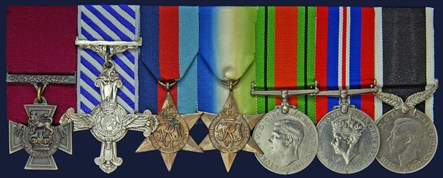
Lloyd Trigg
The final V.C. to be sold at auction in the 1990s was the V.C. to Private Thomas Flawn. Sixteen years previously it had sold at Spink for the then extremely high price of £19,000; this time, at Sotheby's on the 26 November 1999, it sold for £70,000 (£80,500 including premium), a roughly four-fold increase, and an indication that the V.C. market was going from strength to strength. The 1980s had seen 60 V.C.s offered for sale at auction, at an average price of just over £20,000; the 1990s had seen 86 V.C.s offered for sale at auction, by far the most of any decade, at an average price of nearly £44,000. The first decade of the 21 Century, by contrast, would see just 40 V.C.s appear at auction. Full details of these, and indeed those that have been sold in the last year, will be covered in Part 3.
Progression of the World Record Price at Auction for a Victoria Cross 1983-1999:
Flight Lieutenant James Nicolson, Royal Air Force
£105,000
Glendining's 1st April 1983
Lieutenant William Rhodes-Moorhouse, Royal Flying Corps
£115,000 (£126,500 including premium)
Sotheby's 15th September 1990
Major Edward Mannock, Royal Air Force
£120,000 (£132,000 including premium)
Sotheby's 19th September 1992
Flying Officer Lloyd Trigg, Royal New Zealand Air Force
£120,000 (£138,000 including premium)
Spink 6th May 1998



